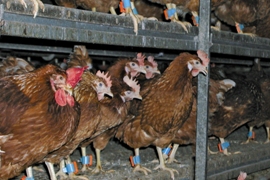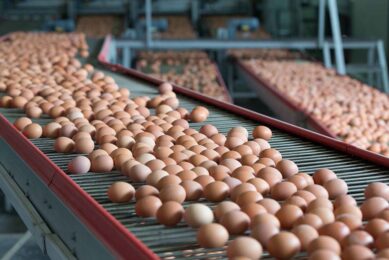Selecting for better nest acceptance

From January 2012, the EU-wide cage ban for layers will come into practice. This demands a different management approach, specifically for aviary systems, as the behaviour of layers plays a part. Specific selection, such as for nest acceptance, oviposition time and duration of stay in the nest, are important traits for avoiding floor eggs.
By Dr. Wiebke Icken, Lohmann Tierzucht, Cuxhaven, Germany
In order to meet consumer preferences, breeding goals are constantly being readjusted. A number of different aspects concerning laying performance, egg quality, feed efficiency as well as the health and behaviour of laying hens are considered.
For continuous improvement, more than twenty characteristics are included in the selection index, which is the basis of every breeding programme. In the overall selection index, each characteristic is weighted in relation to market requirements and exactly defined to meet those needs. In recent years, egg producer’s demand for good nesting behaviour, especially nest acceptance, has grown, but until now it has been difficult to record the necessary individual bird information.
Group housing system
First of all, the selection traits have to be specifically captured for all selection candidates and preferably in a housing system which is similar to the production system. Such accurate data recording in group housing systems is a challenge to the breeding company and their testing methods. In the past, production information for individual birds was only possible in single bird cages.
First of all, the selection traits have to be specifically captured for all selection candidates and preferably in a housing system which is similar to the production system. Such accurate data recording in group housing systems is a challenge to the breeding company and their testing methods. In the past, production information for individual birds was only possible in single bird cages.
Behaviour patterns of Lohmann Brown (LB) and Lohmann LSL were captured mainly in conventional group cages on a family basis. Therefore, four to six full sibs are housed in one cage and the family information is included in the selection. In this way, behavioural characteristics relating to feather cover have been improved by breeding. These cage-based testing methods, however, do not allow data collection of nesting behaviour traits and thus, a completely new testing system was developed by Lohmann Tierzucht and the Bavarian State Research Centre, Freising, Weihenstephan.
Management aspects
The so-called “Weihenstephan funnel nest box” (FNB), enables hen specific data recording in a non-cage environment, which is additionally used in the breeding programme of Lohmann layers. Since 2005, Lohmann pedigree hens have been tested in these special nests for their laying performance, egg quality traits, nesting behaviour and nest acceptance. Therefore, in that time, the number of saleable nest eggs has increased and simultaneously, floor eggs have decreased.
The so-called “Weihenstephan funnel nest box” (FNB), enables hen specific data recording in a non-cage environment, which is additionally used in the breeding programme of Lohmann layers. Since 2005, Lohmann pedigree hens have been tested in these special nests for their laying performance, egg quality traits, nesting behaviour and nest acceptance. Therefore, in that time, the number of saleable nest eggs has increased and simultaneously, floor eggs have decreased.
Management and training at the beginning and during the rearing period can influence the most important nesting behaviour trait, nest acceptance. After transfer to the production house, the adjustment of the lighting programme in relation to performance and frequent collection of non-nest eggs, are the most important management aspects which have to be considered for a successful production period.
Individual egg registration
As a basis for genetic improvement, Lohmann geneticists use the variation in nesting behaviour between selection candidates. Differences between layers of one flock are automatically determined with the aid of the FNB. Each hen is tagged with a transponder on her leg and the funnel nest floor is equipped with an antenna. This antenna transponder mechanism, technology well known in dairying, guarantees the clear identification of each hen in the nest.
As a basis for genetic improvement, Lohmann geneticists use the variation in nesting behaviour between selection candidates. Differences between layers of one flock are automatically determined with the aid of the FNB. Each hen is tagged with a transponder on her leg and the funnel nest floor is equipped with an antenna. This antenna transponder mechanism, technology well known in dairying, guarantees the clear identification of each hen in the nest.
Trap devices at the entrance of the FNB ensure that the single nest box is only occupied by one hen at any one time. The funnel nest floor locks the nest while a hen is inside and helps to orientate the hen to place its head towards the nest entrance guaranteeing that every egg rolls out of the nest immediately after being laid and is simultaneously registered at a seesaw egg sensor.
| The experimental house is equipped with a series of individual funnel nest boxes. | In the house with funnel nest boxes, egg collection and labelling is done for quality assessment. |
All the eggs from one nest are collected in sequence of laying along an adjacent tube. The combination of the transponder signal, the signal from the egg sensor and the position of the egg in the egg collecting tube, enables the assignment of each egg to an individual hen which is the basis for genetic analyses of the important selection traits: egg number, egg quality characteristics and nesting behaviour.
Brown and white differ
Nest acceptance is analysed by counting the number of “saleable” eggs laid in the FNB. On the basis of the recorded number of nest eggs per hen, a family breeding value can be estimated for egg production, taking into account nest acceptance and nesting behaviour, which are then combined with traditional selection criteria in a selection index.
Nest acceptance is analysed by counting the number of “saleable” eggs laid in the FNB. On the basis of the recorded number of nest eggs per hen, a family breeding value can be estimated for egg production, taking into account nest acceptance and nesting behaviour, which are then combined with traditional selection criteria in a selection index.
Nest occupation and oviposition times are among the factors that determine the nest space needed (Figure 1). Hens which visit the nest only shortly before oviposition, lay their eggs quickly and then leave the nest as soon as possible to make room for other hens, are the ones preferred by egg producers. Apart from less direct investments for nests, soiling of nests and eggs could also be reduced by shorter nest occupation times.
Results of tested LB and LSL lines have shown significant differences in their oviposition and nest occupation times. While the brown-egg layers spread its nest visits over more than four hours during the morning, the white-egg layers concentrate the nest visits within a period of two hours. Additionally, hens of LSL origin spend more time in the nest as compared to LB hens.
More space needed
While the LB layers occupy the nests for an average of 30 minutes, the white egg layers spend around 45 minutes in the nest for each oviposition (Table 1). Nest visits without oviposition were mainly observed at the beginning of the observation period, when hens habitually explore their new environment.
While the LB layers occupy the nests for an average of 30 minutes, the white egg layers spend around 45 minutes in the nest for each oviposition (Table 1). Nest visits without oviposition were mainly observed at the beginning of the observation period, when hens habitually explore their new environment.
Nest visits without oviposition lasted an average of 10 minutes for brown layers and nearly half an hour for white layers. The narrow time range of white egg layers in terms of their oviposition time combined with longer nest visits, means they require a longer nest occupation per egg laid. Therefore, more nest space is needed as compared to brown egg-layers in order to avoid floor eggs.
Join 31,000+ subscribers
Subscribe to our newsletter to stay updated about all the need-to-know content in the poultry sector, three times a week. Beheer
Beheer








 WP Admin
WP Admin  Bewerk bericht
Bewerk bericht